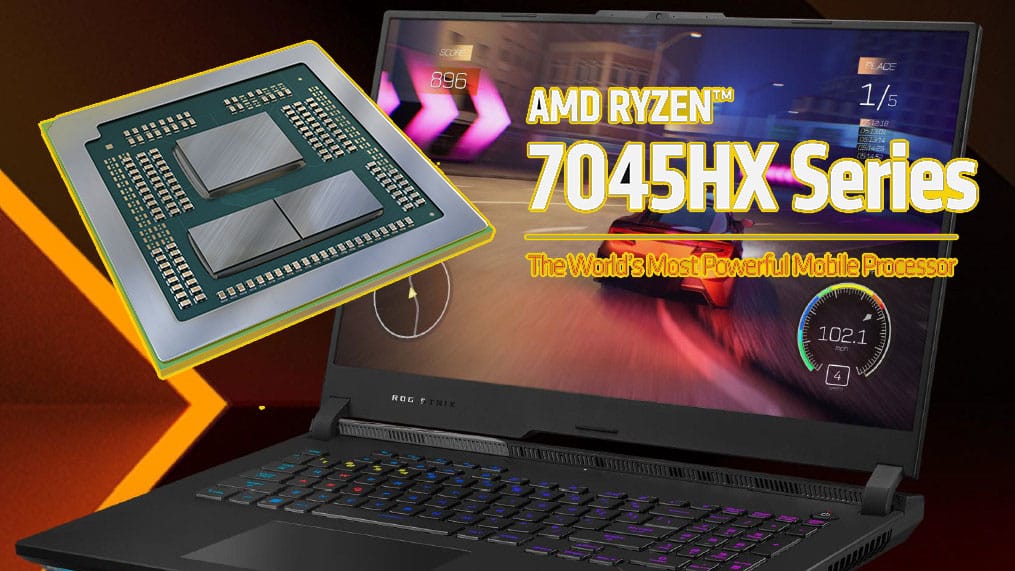Epilogue
For the first time, AMD brings the 3D V-cache technology to laptops through the Ryzen 9 7945HX3D processor, which will be only available with one laptop model, the Asus ROG Strix Scar 17 X3D. This laptop is a beast, featuring an RTX 4090 (laptop edition) and a 240Hz QHD screen, ideal for gaming. AMD’s “Zen 4” architecture already showed its strength, especially in the gaming section, with the Ryzen 7 7800X3D, which currently is the fastest gaming processor that you can get. But why stay in desktop systems when you can deliver something equally strong for laptops? This is what AMD thought and offered a “laptop” edition of the 7950X3D for the FL1 platform. With 16 cores and 32 processing threads, the 7945HX3D is not only ideal for gaming but also for demanding applications able to utilize multiple cores, and this is shown by the overall performance graph where the processor takes over the third place, behind the i9-13900K, which needs way more power, and the Ryzen 9 7950X3D.
Compared to the desktop Ryzen 7000X3D models, AMD made some changes to power management, including voltage range tuning and intermediate memory states to lower power consumption even more. During an intensive CPU stress load, I found that the average power consumption is close to the 55W AMD states as TDP for this processor, but I noticed some high power spikes with the maximum exceeding 100W. Moreover, the aggressive fan speed profile of the Asus laptop, with the “performance” mode enabled, looks not to have an easy time cooling down the laptop’s CPU and GPU. With an average noise output of 37.4 dBA and a maximum recorded value close to that, I cannot call the Asus ROG Strix SCAR 17 X3D quiet; it is far from it. I know firsthand that gaming laptops are not quiet since they pack strong hardware in a compact chassis, so their cooling systems need to use strong fans to handle the thermal loads.
I am looking forward to seeing the equivalent of the Ryzen 7 7800X3D an Ryzen 7 7745HX3D, in a future release, for more affordable laptops since not many can afford the high price of the Asus ROG Strix SCAR 17 X3D, which will exceed 3500 dollars, given that the similar spec Asus ROG Strix SCAR 17 equipped with the Ryzen 9 7945HX goes for $3450.
- Good gaming performance
- Highly overall performance
- Highly efficient
- PCIe 5.0 support
- Integrated GPU
- DDR5 support
- AVX512 and AI instructions support
- 89°C thermal limit is relatively low for laptop use
- CPU package power spikes exceeding 100W
- Increased platform cost
- Strong cooling is required for optimal performance






2) Turd of LDC-IPS. What a crap with 1000 – 1200:1 contrast and the usual LCD flaws. Even more crap because it has a AG-coating (matte) which further pulls image quality down the toilet (especially the contrast, which attributes to image quality the most). No one seriously needs 240 Hz either. 4K-UHD, at least W-Oled (better QD-Oled) 120 Hz is expected for 3500 bucks.
1500 bucks, 17 inch business notebooks get W-OLED with 4K-UHD resolution.
You didn’t even mentioned this once. You can put whatever future RTX 20090 in it – the image quality still is very low, because the last link in the chain, the display (what we perceive), is low image-quality garbage.
3) AMD is milking customers with their Ryzen processors too, this Ryzen 9 7945HX3D. The chiplet-design is negatively affecting performance, power draw and thus efficiency. Noticeably with one chiplet, even more here 2 chiplets here. Intel’s new mobile processors are already very close in terms of efficiency to this one here (despite not having stacked cache).
It’s only meant for AMD to get higher product margins. They could went for the superior but costlier monolithic design, as seen with the upcoming “12 core Strix Point”.
But why give customers better products if can get higher product margin?!
3) Typical Asus overpriced-tax. Such price yet such underwhelming build. Why make the chasis so thin in height and the cooling so bad? I don’t say it has to be a 7 kg desktop-replacement, but this 3 kg is a joke! No one smart will use this for serious 200 – 300 watts gaming on battery; it lasts maybe 30 minutes. This is meant to be plugged in, and here weight is no problem at all. So make it 4 kg and beef up the cooling.
75 ° average and almost 90 ° Celsius peak for the processor is bad.
38 dB while gaming at native resolution is very loud, given the laptop is directly in front of the user.
The provided noise audio sounds very loud. Whats the point of this, if the user can’t focus on the game, being distraced by noise?
For 3.5k it should have the best thermals and builds.
I’m saying this pretty blunt and full of critique, because that’s what it is; can’t wrap this customer-milking and your partly dishonest test in pretty words. This laptop has to cost 2 – 2.4k bucks at most.
Inflation or whatever recession is no excuse here.
I’m disappointed. Please remove whatever award asap.
You shouldn’t buckle before these companies, just because they provide free review samples. They should buckle before you testers.
I sincerely hope you do it better next time (and change it now), because that’s what you and this website deserve!
Cheers